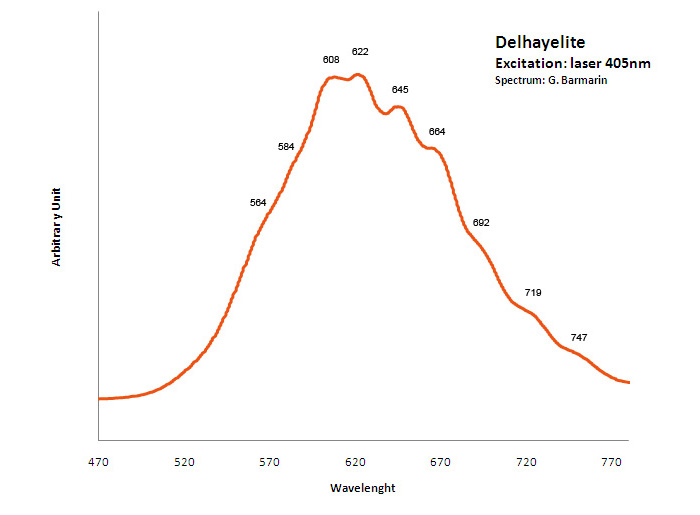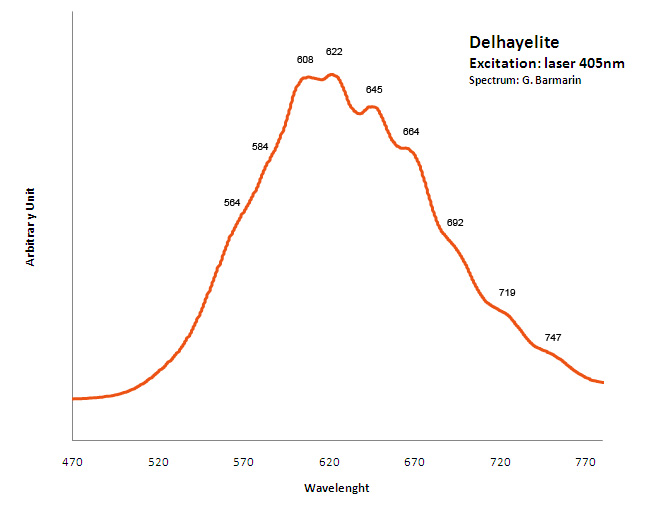Database of luminescent minerals
DELHAYELITE
Chemical formula: (Na,K)10Ca5Al6Si32O80(Cl2,F2,SO4)3 18H2O
Family: Silicates
Status: IMA-GP
Crystal system : Orthorhombic
Display mineral: NON
Luminescence:
Longwave UV (365nm) colors: |
Orange , | ||
Intensity LW:Strong | |||
Shortwave UV (254nm) colors: |
Orange , | ||
Intensity SW:Medium | |||
Do you have a photo of this mineral you would like to see in the gallery? Contact us!
Phosphorescence (in the common sense of the term) observable with the naked eye:
No data
Comments:
Named in 1959 by Th. G. Sahama and K. Hytönen after Fernand Delhaye (Clermont-Ferrand February 4 1880 - Saint-Gillis (Brussels) December 15 1946), of Belgian nationality. He worked in Central Africa (Type locality for Delhayeite: Mt Shaheru, Mt Nyiragongo, Goma, Kivu, Democratic Republic of Congo (Zaïre) type specimen conserved at Royal Museum for Central Africa, Tervuren seems not to be luminescent).
Activator(s) and spectrum:
Activator(s): S2-, Ce3+, Sm3+, Eu3+, Dy3+, Mn2+ , Nd3+,
Peaks in the spectrum (nm):
S2- : large band centered at 620nm with weak vibrational structure (564, 584, 608, 622, 645, 664, 692, 719, 747nm)

Delhayelite.
Excitation: laser 405nm. Col. G. Barmarin; Spectre: G. Barmarin
Spectrum Galery:



 ...
...Comments on spectrum and activators:
Delhayelite was studied by steady-state luminescence and S2- , trivalent REE, such as Ce, Dy, Sm, and Mn2+ were found. Excitation by CW laser at 532 and 785 nm revealed trivalent REE, mainly Eu and Nd, and evidently S2- band (Gaft).
Best localities for fluorescence (*):
- Kirovskii apatite mine, Kukisvumchorr Mt, Khibiny Massif, Kola Peninsula, Murmanskaja Oblast, Northern Region, Russia;
- Yukspor Mt, Khibiny Massif, Murmansk Oblast, Russia;
- Koashva Open Pit, Koashva Mt, Khibiny Massif, Murmansk Oblast, Russia;
- Rasvumchorr Mine, Rasvumchorr Mt, Khibiny Massif, Murmansk Oblast, Russia;
(*)The data are not exhaustive and are limited to a few remarkable localities for fluorescence
Bibliographic reference for luminescence:
- Fluorescence: Gems and Minerals Under Ultraviolet Light, Manuel Robbins, 1994, Geoscience Press, ISBN 0-945005-13-X ,
- Luminescent Spectra of Minerals, Boris S. Gorobets and Alexandre A. Rogojine, Moscow, 2002 ,
Reference for luminescence on the Internet:
Images:
- Kukisvumchorr Mt, Khibiny Massif, Kola Peninsula, Russia: https://www.mindat.org/photo-661537.html
- Rasvumchorr Mt, Khibiny Massif, Russia : https://www.mindat.org/photo-777159.html
Mineralogical reference on the Internet:
 http://www.mindat.org/show.php?name=Delhayelite
http://www.mindat.org/show.php?name=Delhayelite
 http://webmineral.com/data/Delhayelite.shtml
http://webmineral.com/data/Delhayelite.shtml
Internet Search:
 Image search on 'Google Images'
Image search on 'Google Images'
 Search for documents in all languages on Google
Search for documents in all languages on Google
A request providing no result means only that no such reference exists in the database, but it does not mean that what you are looking for does not exist, just not to our knowledge. If you think you have found an error or omission, please let us know via the contact page being sure to cite the source of information.

